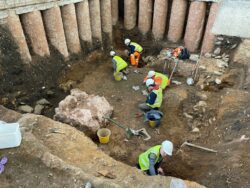The existence of a Roman temple underneath the cathedral had so far been a folk tale (Picture: PA)
An archaeological dig has uncovered what is believed to be a Roman shrine beneath a graveyard in Leicester.
Excavations at the site of an old song school in the grounds of Leicester Cathedral began in October 2021 and have since produced a ‘remarkable’ amount of information, dig directors have said.
The cellar of a Roman building and a 1,800-year-old altar stone have been discovered during the excavation, led by University of Leicester Archaeological Services (Ulas), suggesting the presence of a shrine or cult room.
The cellar – now nearly 10ft (3m) below the ground – is believed to have had a concrete floor and stone walls, with decorative paintwork.
‘It could be really significant. It’s an area of Leicester that we don’t get to excavate very often. It’s the historic quarter of the town, so it’s one of those big blank areas on the map of the city,’ said Mathew Morris, who led the dig.
The cellar of a Roman building and a 1,800-year-old altar stone have been discovered during the excavation (Picture: PA)
‘But it’s also quite fundamental in understanding the history of Leicester Cathedral. Whilst it’s an iconic building in the cityscape, we don’t actually know too much about its early history and most of what you see above ground today was rebuilt in the Victorian period,’
‘So an excavation next to it was really the only way we were going to get to grips with key questions, like when was it first founded, and what was underneath it before?’
The existence of a Roman temple underneath the cathedral had so far been a folk tale.
With the discovery of the cellar and the fragment of a Roman altar stone out of it, scientists confirmed that there definitely was a Roman place of worship underneath the cathedral.
It is believed the cellar was built in the second century and then deliberately filled in a century or two later and used as a place to worship God or gods.
Several pieces of Roman pottery and coins were also found.
Several pieces of Roman pottery and coins were also found (Picture: PA)
The dig was part of the planning conditions of the Leicester Cathedral Revealed project, a £12.7 million restoration of the building which is believed to have first been built in the 11th century.
The area of land that was excavated, in the middle of the medieval town, was just 150 square feet (14 square metres), but Morris said ‘if you dig any hole in Leicester, you’re going to find something’.
As well as evidence of Roman activity, 1,100 burials dating from the 11th century to the mid-19th century have also been discovered, which will be analysed and then reinterred at a later date by the cathedral.
The dig has also uncovered rare evidence from the Anglo-Saxon period, including the first coin from the period to be found in the city in 20 years and potentially the first proof of a building from the era in that part of the city.
‘This excavation has produced a remarkable amount of archaeological evidence from a modestly sized area. The project allowed us to venture into an area of Leicester that we rarely have the opportunity to investigate, and it certainly did not disappoint,’ said John Thomas, deputy director at Ulas.
‘Fortunately, the archaeology was very well-preserved and, whilst there is still a lot of analysis work still to do, we are confident that we’ll be able to address all of our questions and more,’
The team hopes to have a much clearer idea of what was happening on the site in the Roman period, when the parish church of St Martin’s was founded, while giving a unique insight into the story of Leicester through its residents who were buried here for over 800 years.
MORE : Ghost of 17th century executioner ‘scratches’ and ‘bruises’ guests during Edinburgh graveyard tour
MORE : ‘Sonic boom’ heard in Leicester and beyond ’causes homes and ground to shake’
Several pieces of Roman pottery and coins were also found.





